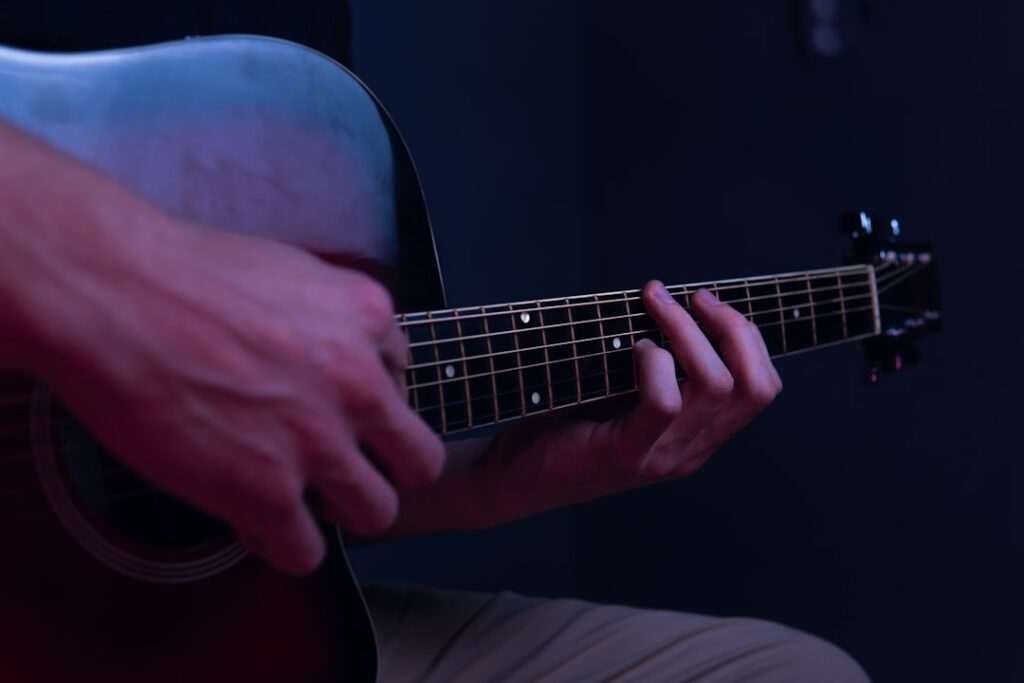
The Fmaj7 chord is a beautiful and versatile chord that is commonly used in various genres of music, including pop, jazz, and R&The Fmaj7 chord is made up of four notes: F, A, C, and E. The Fmaj7 chord has a rich and warm sound that can add depth and emotion to your music. It is often used as a substitute for the regular F major chord, adding an extra layer of complexity and sophistication to your playing. The Fmaj7 chord is a favorite among songwriters and musicians for its dreamy and ethereal quality.
The Fmaj7 chord is made up of the F note as the root, A as the major third, C as the perfect fifth, and E as the major seventh. When played on the guitar, the Fmaj7 chord is typically played with a barre on the first fret, using the index finger to hold down all the strings on the first fret, and then using the other fingers to form the rest of the chord shape. The Fmaj7 chord can be played in various positions on the guitar neck, allowing for different voicings and tonal qualities. Understanding the structure and composition of the Fmaj7 chord is essential for mastering its sound and incorporating it into your playing.
Key Takeaways
- The Fmaj7 chord is a beautiful and versatile chord that adds a rich, jazzy sound to your playing.
- To play the Fmaj7 chord, place your index finger on the first fret of the B string, your middle finger on the second fret of the G string, and your ring finger on the third fret of the D string.
- When strumming the Fmaj7 chord, try using a light and relaxed motion to create a smooth and mellow sound.
- Common variations of the Fmaj7 chord include the Fmaj7 barre chord and the Fmaj7add11 chord, which can add different flavors to your playing.
- To smoothly transition to and from the Fmaj7 chord, practice switching between it and other common chords like C, G, and Am.
Finger Placement for the Fmaj7 Chord
To play the Fmaj7 chord on the guitar, you will need to use a specific finger placement to achieve the correct sound. Start by placing your index finger across all six strings on the first fret. This will act as a barre and will allow you to play all the necessary notes for the Fmaj7 chord. Next, place your middle finger on the second fret of the G string, your ring finger on the third fret of the D string, and your pinky finger on the third fret of the B string. This finger placement will create the full Fmaj7 chord shape.
Another common way to play the Fmaj7 chord is by using a partial barre with your index finger. In this variation, you would only barre the first two strings on the first fret with your index finger, and then use your middle finger to fret the second fret of the G string, your ring finger to fret the third fret of the D string, and your pinky finger to fret the third fret of the B string. This variation may be easier for some players, as it requires less finger strength to hold down the barre. Experiment with both finger placements to see which one feels more comfortable for you.
Strumming Patterns for the Fmaj7 Chord
Once you have mastered the finger placement for the Fmaj7 chord, it’s time to explore different strumming patterns to bring this chord to life. The Fmaj7 chord has a dreamy and ethereal quality that can be enhanced by using gentle and flowing strumming patterns. One popular strumming pattern for the Fmaj7 chord is a simple down-up strumming pattern. Start by strumming down on the chord, then immediately strum up, creating a continuous flow of sound. This strumming pattern works well for slower songs and ballads, allowing the rich tones of the Fmaj7 chord to shine through.
Another strumming pattern that complements the Fmaj7 chord is a fingerpicking pattern. Use your thumb to pluck the bass note (F) on the sixth string, then use your index, middle, and ring fingers to pluck the A, D, and G strings respectively. This fingerpicking pattern creates a delicate and intricate sound that highlights the complexity of the Fmaj7 chord. Experiment with different strumming patterns and fingerpicking techniques to find the right fit for your playing style and musical preferences.
Common Variations of the Fmaj7 Chord
| Variation | Fingering | Notes |
|---|---|---|
| Fmaj7 | 1-3-2-0-1-0 | F-A-C-E |
| Fmaj7/A | X-0-3-2-1-0 | A-C-E-F |
| Fmaj7/C | X-3-3-2-1-0 | C-E-F-A |
| Fmaj7/E | E-F-A-C |
There are several common variations of the Fmaj7 chord that can add depth and complexity to your playing. One popular variation is the Fmaj9 chord, which adds a ninth note (G) to the Fmaj7 chord. To play the Fmaj9 chord, simply lift your pinky finger from the third fret of the B string, allowing the open E string to ring out. This variation creates a lush and jazzy sound that can be used in various musical contexts.
Another common variation of the Fmaj7 chord is the Fmaj7add6 chord. This variation adds a sixth note (D) to the Fmaj7 chord, creating a slightly different tonal quality. To play the Fmaj7add6 chord, simply lift your ring finger from the third fret of the D string, allowing the open string to ring out. This variation has a bright and airy sound that can add a unique flavor to your music.
Tips for Smoothly Transitioning to and from the Fmaj7 Chord
Transitioning smoothly to and from the Fmaj7 chord can be challenging for beginner guitarists, but with practice and patience, it can be mastered. One tip for transitioning to the Fmaj7 chord is to visualize the shape of the chord before placing your fingers on the fretboard. By mentally preparing for the chord shape, you can make the transition smoother and more efficient. Additionally, practicing transitioning between chords that are commonly used with Fmaj7, such as C major and G major, can help improve your overall dexterity and muscle memory.
Another tip for smoothly transitioning to and from the Fmaj7 chord is to use pivot fingers when possible. Pivot fingers are fingers that remain in place when transitioning between chords, providing an anchor point for your hand as you move between shapes. For example, when transitioning from a C major chord to an Fmaj7 chord, you can leave your ring finger on the third fret of the A string as you move your other fingers into position for the Fmaj7 chord. This technique can make transitions smoother and more seamless.
Songs to Practice the Fmaj7 Chord

There are many popular songs that feature the Fmaj7 chord, making it a great chord to practice and incorporate into your repertoire. One classic song that prominently features the Fmaj7 chord is “Dreams” by Fleetwood Mac. The iconic guitar riff in this song revolves around the Fmaj7 chord, making it an essential song for practicing this chord. Another popular song that uses the Fmaj7 chord is “Put Your Records On” by Corinne Bailey Rae. The gentle and uplifting sound of this song is enhanced by the use of the Fmaj7 chord throughout.
For those interested in jazz music, “Misty” by Erroll Garner is a timeless standard that prominently features the Fmaj7 chord. The lush and romantic sound of this song is built around beautiful voicings of the Fmaj7 chord, making it an excellent choice for practicing this chord in a jazz context. “Sunday Morning” by Maroon 5 is another contemporary song that uses the Fmaj7 chord in its catchy and infectious melody. Practicing these songs will not only help you master the Fmaj7 chord but also expand your musical repertoire.
Advanced Techniques for the Fmaj7 Chord
Once you have mastered the basics of playing the Fmaj7 chord, there are several advanced techniques that you can explore to further enhance your playing. One advanced technique is to experiment with different voicings of the Fmaj7 chord across the guitar neck. By using different fingerings and positions, you can create unique and interesting sounds with this versatile chord. Additionally, incorporating extensions such as ninths or thirteenths into your Fmaj7 voicings can add complexity and sophistication to your playing.
Another advanced technique for the Fmaj7 chord is to explore arpeggios and melodic patterns using this chord shape as a foundation. Arpeggiating the notes of an Fmaj7 chord across multiple octaves can create a cascading and ethereal sound that is perfect for intros or interludes in your music. Experiment with different picking patterns and rhythmic variations to create dynamic and engaging arpeggios with the Fmaj7 chord.
In conclusion, mastering the Fmaj7 chord opens up a world of musical possibilities for guitarists. Understanding its structure and composition, mastering finger placement and strumming patterns, exploring variations and transitions, practicing songs that feature this chord, and delving into advanced techniques will all contribute to becoming proficient in playing this beautiful and versatile chord. With dedication and practice, you can incorporate the Fmaj7 chord into your playing style and elevate your musical expression.
Sure, here’s a paragraph for you:
If you’re looking to expand your guitar chord repertoire, the Fmaj7 chord is a great addition to your arsenal. This versatile chord can add a touch of sophistication to your playing and is commonly used in jazz, pop, and R&B music. To learn more about mastering the Fmaj7 chord and incorporating it into your playing, check out this insightful article on ATCollab. Whether you’re a beginner or an experienced guitarist, this article offers valuable tips and techniques to help you perfect the Fmaj7 chord and take your playing to the next level.
FAQs
What is an Fmaj7 guitar chord?
An Fmaj7 guitar chord is a four-note chord consisting of the notes F, A, C, and E. It is commonly used in jazz, pop, and other genres of music.
How is the Fmaj7 guitar chord played?
To play the Fmaj7 chord on the guitar, place your index finger on the first fret of the high E string, your middle finger on the second fret of the G string, your ring finger on the second fret of the D string, and your pinky on the third fret of the A string. Strum from the A string down to the high E string.
What are some common variations of the Fmaj7 chord?
Some common variations of the Fmaj7 chord include the Fmaj7 barre chord, which is played by barring the first fret with your index finger and forming the rest of the chord shape with your other fingers, and the Fmaj7/A chord, which is played by placing your thumb on the low E string and muting the A string while playing the rest of the Fmaj7 chord shape.
Where can I use the Fmaj7 guitar chord in a song?
The Fmaj7 chord can be used in various parts of a song, including as a substitute for the F major chord in a progression, as a passing chord, or as a part of a jazz or bossa nova style chord progression. It can also be used in intros, verses, choruses, and bridges.


